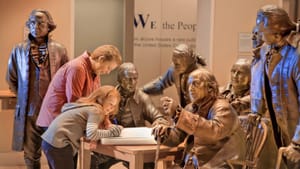Stay in the Loop
BSR publishes on a weekly schedule, with an email newsletter every Wednesday and Thursday morning. There’s no paywall, and subscribing is always free.
The future under glass
The future of museums

What will museums look like in 2050?
That will be high time for an Internet Museum, but what’s a curator to exhibit? Vintage devices of increasing power and decreasing size? A Hall of Fame/Infamy, with holographic busts of Mark Zuckerberg, Steve Jobs, Bill Gates, Julian Assange, Edward Snowden, and the AOL running man? Visitors could enter the portal of 'net nostalgia through a curtain of floppy discs, and experience designers could pipe in that grating boing-boing-ding-boing sound from dial-up days. Tickets would be priced according to the speed of entry: Willing tourists save if they wait in a queue and watch those swirly things twirl across the floor.
The 21st-century butter churn
Google glasses will be old news by 2050, so they’ll be in the collection, and maybe a few mouses. Older museumgoers will be transported, remembering all the clicking they did, and younger ones will want to try them out. The mouse will be the butter churn of the Internet Museum.
But will this or any museum be of interest by the middle of the 21st century? Museums run on objects, and even now, everyday life is becoming more ephemeral. With dot-coms, -orgs, -nets, and hashtags, we are quickly becoming a century@intangible.
Will people accustomed to accessing the world in their palms want to walk historic streets, sit in concert halls, or visit art? Will they travel to see important artifacts from the past, such as the documents from the summer of 1776, currently on view in Philadelphia?
A complete draft of the Declaration of Indenpendence opens the American Philosophical Society Museum exhibit, two tablet-sized pages covered on both sides with remarkably small and clear writing. Though stained along its folds, it looks fine for having traveled through 238 years. The lines of text are even, the letters exquisitely formed.
What will the future cherish?
What will people cherish 238 years from now? With so many ways to communicate, will anyone be as sentimental about a nimbus of emails as my mother was about a ribbon-tied packet of letters from my father, written during World War II?
Will the Obamas’ digital correspondence be valued and shared as John and Abigail Adams’ letters were? Will blogs rival leather-bound journals? Preservation is so effortless, will future historians be able to find their way through the centillions of mundane documents to those that matter most? Is something being written right now that people in 2252 will revere, or even remember?
It is impossible to know what the future holds, so let’s focus on the present. In 2014, people still seem to appreciate the treasures of the past and value seeing them in person. They still line up to see the Liberty Bell and pose for pictures with the signer statues at the National Constitution Center. At the APS, they pocket their smartphones to pause and read the pages that lit the fuse of a nation. Here and now, we enjoy a wealth of history before our eyes and a world of information at our fingertips.
Sign up for our newsletter
All of the week's new articles, all in one place. Sign up for the free weekly BSR newsletters, and don't miss a conversation.